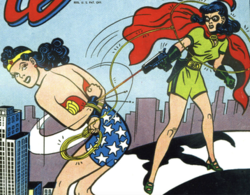
William Moulton Marston, also known by the pen name Charles Moulton, was an American psychologist who, with his wife Elizabeth Holloway, invented an early prototype of the polygraph. He was also known as a self-help author and comic book writer who created the character Wonder Woman.

Wonder Woman is a superheroine created by the American psychologist and writer William Moulton Marston, and artist Harry G. Peter in 1941 for DC Comics. Marston's wife, Elizabeth, and their life partner, Olive Byrne, are credited as being his inspiration for the character's appearance.

Wonder Girl is the alias of multiple superheroines featured in comic books published by DC Comics. Donna Troy, the original Wonder Girl, was created by Bob Haney and Bruno Premiani and first appeared in The Brave and the Bold #60. The second Wonder Girl, Cassie Sandsmark, was created by John Byrne and first appeared in Wonder Woman #105. Both are protégées of Wonder Woman and members of different incarnations of the Teen Titans. The alias has also been used in reference to a younger version of Wonder Woman as a teenager. In the 2020s, DC introduced a third Wonder Girl in Yara Flor, who hails from a Brazilian tribe of Amazons and was shown in a flashforward to one day succeed Diana as Wonder Woman.
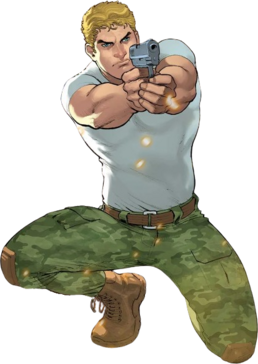
General Steven Rockwell Trevor is a fictional character appearing in American comic books published by DC Comics, commonly in association with the superhero Wonder Woman. The character was created by William Moulton Marston and first appeared in All Star Comics #8. Steve Trevor is a trusted friend, love interest, and partner of Wonder Woman who introduced her to "Man's World", and has served as her United Nations liaison. He is the first foreigner to have ever set foot on Themyscira and the first ambassador to open diplomatic relations with the Amazons.

Wonder Woman, known for seasons 2 and 3 as The New Adventures of Wonder Woman, is an American superhero television series based on the DC Comics comic book superhero of the same name. It stars Lynda Carter as Wonder Woman / Diana Prince and Lyle Waggoner as Steve Trevor Sr. and Jr., and aired for three seasons, from 1975 to 1979. The show's first season aired on ABC and is set in the 1940s, during World War II. The second and third seasons aired on CBS and are set in the then-current day late 1970s, with the title changed to The New Adventures of Wonder Woman.
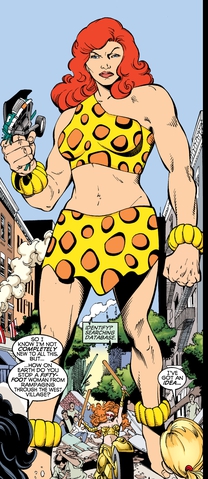
Giganta is a fictional character appearing in DC Comics publications and related media, commonly as a recurring adversary of the superhero Wonder Woman, and an occasional foil of the superhero the Atom. She debuted as a brutish strongwoman in 1944's Wonder Woman #9, written by Wonder Woman creator William Moulton Marston and illustrated by Harry G. Peter, and went on to become one of Wonder Woman's most recognizable and persistent foes, appearing during every major era of the hero's comic book adventures, and adapted frequently for television and animation.
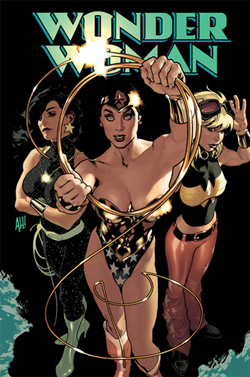
The Lasso of Truth is a weapon wielded by DC Comics superhero Wonder Woman, Princess Diana of Themyscira. It is also known as the Lariat of Truth, the Magic Lasso, the Lasso of Hestia or the Golden Perfect. It was created by William Moulton Marston, inventor of the lie detector, as an allegory for feminine charm, but it later became more popular as a device to extract truth from people.

The Invisible Plane is a plane appearing in DC Comics, commonly used by Wonder Woman as a mode of transport. It was created by William Moulton Marston and first appeared in Sensation Comics #1.

Etta Candy is a fictional character appearing in DC Comics publications and related media, commonly in association with Wonder Woman. Spirited and vivacious, with a devil-may-care attitude, Etta debuted as a young white woman with red hair in 1942's Sensation Comics #2, written by Wonder Woman's creator William Moulton Marston.
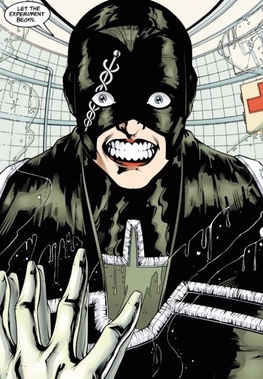
Doctor Poison is a fictional character appearing in DC Comics publications and related media, commonly as a recurring adversary of the superhero Wonder Woman. A sadistic bioterrorist with a ghoulish face, she first appeared in 1942’s Sensation Comics #2, written by Wonder Woman creator William Moulton Marston and illustrated by Harry G. Peter, and holds a distinction as Wonder Woman’s first costumed supervillain.
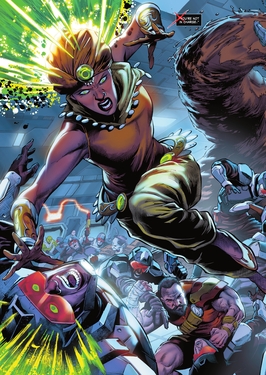
Hypnota is a fictional character appearing in DC Comics publications and related media, commonly as a recurring adversary of the superhero Wonder Woman. Created by writer William Moulton Marston and artist Harry G. Peter, the character debuted in 1944 in Wonder Woman #11 as a stage magician and human trafficker with powerful superhuman mind-control abilities. The gender presentation of her stage persona, Hypnota the Great, was that of an ostensibly male figure in Orientalized Middle-Eastern costume, complete with a false mustache and goatee. Though initially disguising her gender to deflect criminal suspicion, Hypnota made subsequent Golden Age appearances in her masculine stage garb; even after her supposedly "true" gender identity was revealed, she chose to present as a man – a move that might be understood in the 21st century as genderqueer. The Modern Age Hypnota has abandoned her false facial hair and is now depicted as a cisgender woman, albeit one who wears a masculine costume similar to her Golden Age look.
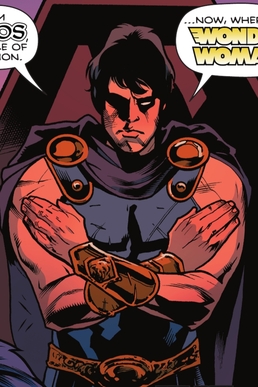
The Duke of Deception is a fictional character appearing in DC Comics publications and related media, commonly as a recurring adversary of the superhero Wonder Woman. Based on Dolos, the Greek mythological deity of deceit and lies, he debuted in 1942’s Wonder Woman #2 as a treacherous operative of the war god Mars/Ares. He would become one of Wonder Woman's most persistent foes, appearing regularly in her adventures throughout the Golden, Silver and Bronze Age of Comics. Evolving into an antagonist independent of Ares, he has frequently confronted Wonder Woman and her allies as a powerful autonomous threat with his own aims of conquest.

The Blue Snowman is a fictional character appearing in DC Comics publications and related media, commonly as a recurring adversary of the superhero Wonder Woman. Created by writer William Moulton Marston and artist Harry G. Peter, the character debuted in 1946 in Sensation Comics #59 as a high-tech extortionist named Byrna Brilyant who used a fearsome costumed persona to coerce money out of innocent victims.
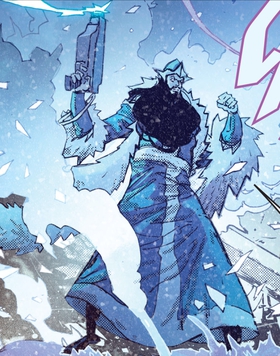
Minister Blizzard is a fictional character appearing in DC Comics publications and related media, commonly as a recurring adversary of the superhero Wonder Woman. A would-be world conqueror from a hidden Arctic civilization, he debuted in 1948 in Wonder Woman #29, written by an uncredited Joye Hummel Murchison and illustrated by Harry G. Peter. One of two members of Wonder Woman's rogues gallery introduced in the 1940s to have an ice/snow motif, Minister Blizzard, was an early progenitor of the comics trope of the ice-gun wielding supercriminal, preceding more recognizable DC Comics antagonists such as Mr. Freeze and Captain Cold, as well as Marvel Comics' Blizzard.

Wonder Woman of Earth-Two is a fictional DC Comics superheroine, from the original stories by Wonder Woman writer and creator, William Moulton Marston and his wife Elizabeth Holloway Marston. After DC Comics established a multiverse in their published stories, which explained how heroes could have been active before World War II, retain their youth, and (subsequent) origins during the 1960s, this version of Wonder Woman was retconned merging with the original Wonder Woman who first appeared in All Star Comics #8.
The portrayal of women inAmerican comic books has often been a subject of controversy since the medium's beginning. Critics have noted that both lead and supporting female characters are substantially more subjected to gender stereotypes than the characters of men.

Mala is the name of two fictional characters in DC Comics, both associated with the Amazons and the Wonder Woman mythos. The first Mala, introduced in the Golden Age, is a Themyscirian Amazon and close ally of Wonder Woman, known for her role in Amazonian contests and managing Reform Island. The second Mala, from the Bana-Mighdall tribe, serves as a historian and guardian of her people's heritage. Mala has appeared in various media adaptations, including the 1975 Wonder Woman TV series, the animated film Justice League: The New Frontier, and the video game DC Universe Online.
The fictional DC Comics character Wonder Woman was created by William Moulton Marston. She was introduced in All Star Comics #8, then appeared in Sensation Comics #1, Six months later, she appeared in her own comic book series. Since her debut, five regular series of Wonder Woman have been published, the fifth launched in June 2016 as part of DC Rebirth.

Wonder Woman is an ongoing American comic book series featuring the DC Comics superhero Wonder Woman and occasionally other superheroes as its protagonist. The character first appeared in All Star Comics #8, later featured in Sensation Comics series until having her own solo title.

Since her debut in All Star Comics #8, Diana Prince/Wonder Woman has appeared in a number of formats besides comic books. Genres include animated television shows, direct-to-DVD animated films, video games, the 1970s live action television series, Wonder Woman, The Lego Movie and The Lego Batman Movie, and the live-action DCEU films Batman v Superman: Dawn of Justice (2016), Wonder Woman (2017), Justice League (2017), Wonder Woman 1984 (2020), Zack Snyder's Justice League (2021), Shazam! Fury of the Gods (2023), and The Flash (2023).

